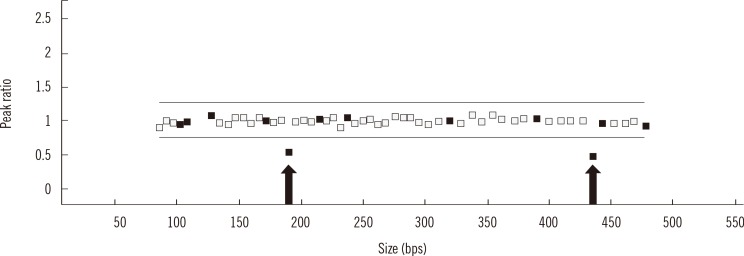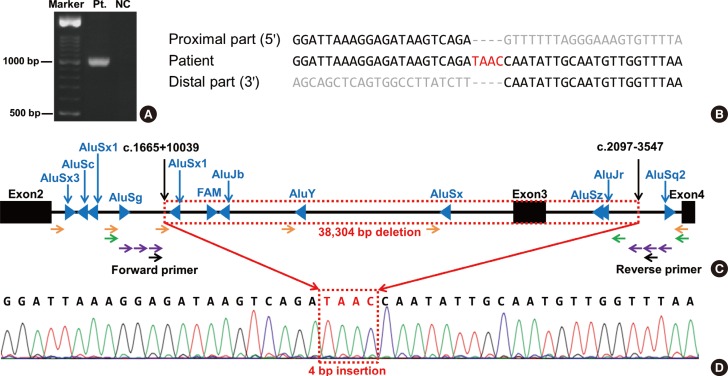Ann Lab Med.
2015 Jan;35(1):141-145. 10.3343/alm.2015.35.1.141.
Non-Homologous End Joining Repair Mechanism-Mediated Deletion of CHD7 Gene in a Patient with Typical CHARGE Syndrome
- Affiliations
-
- 1Department of Laboratory Medicine, Seoul National University Hospital, Seoul, Korea. sparkle@snu.ac.kr
- 2Department of Pediatrics, Seoul National University Children's Hospital, Seoul, Korea.
- KMID: 2363163
- DOI: http://doi.org/10.3343/alm.2015.35.1.141
Abstract
- CHARGE syndrome MIM #214800 is an autosomal dominant syndrome involving multiple congenital malformations. Clinical symptoms include coloboma, heart defects, choanal atresia, retardation of growth or development, genital hypoplasia, and ear anomalies or deafness. Mutations in the chromodomain helicase DNA binding protein 7 (CHD7) gene have been found in 65-70% of CHARGE syndrome patients. Here, we describe a 16-month-old boy with typical CHARGE syndrome, who was referred for CHD7 gene analysis. Sequence analysis and multiplex ligation-dependent probe amplification were performed. A heterozygous 38,304-bp deletion encompassing exon 3 with a 4-bp insertion was identified. There were no Alu sequences adjacent to the breakpoints, and no sequence microhomology was observed at the junction. Therefore, this large deletion may have been mediated by non-homologous end joining. The mechanism of the deletion in the current case differs from the previously suggested mechanisms underlying large deletions or complex genomic rearrangements in the CHD7 gene, and this is the first report of CHD7 deletion by this mechanism worldwide.
MeSH Terms
-
Alu Elements/genetics
Base Sequence
CHARGE Syndrome/diagnosis/*genetics
DNA/chemistry/metabolism
*DNA End-Joining Repair
DNA Helicases/*genetics/metabolism
DNA-Binding Proteins/*genetics/metabolism
Exons
Gene Dosage
Heterozygote
Humans
Infant
Male
Multiplex Polymerase Chain Reaction
Mutation
Sequence Analysis, DNA
*Sequence Deletion
DNA
DNA Helicases
DNA-Binding Proteins
Figure
Reference
-
1. Blake KD, Davenport SL, Hall BD, Hefner MA, Pagon RA, Williams MS, et al. CHARGE association: an update and review for the primary pediatrician. Clin Pediatr (Phila). 1998; 37:159–173. PMID: 9545604.
Article2. Verloes A. Updated diagnostic criteria for CHARGE syndrome: a proposal. Am J Med Genet A. 2005; 133A:306–308. PMID: 15666308.
Article3. Woodage T, Basrai MA, Baxevanis AD, Hieter P, Collins FS. Characterization of the CHD family of proteins. Proc Natl Acad Sci USA. 1997; 94:11472–11477. PMID: 9326634.
Article4. Aramaki M, Udaka T, Kosaki R, Makita Y, Okamoto N, Yoshihashi H, et al. Phenotypic spectrum of CHARGE syndrome with CHD7 mutations. J Pediatr. 2006; 148:410–414. PMID: 16615981.
Article5. Zentner GE, Layman WS, Martin DM, Scacheri PC. Molecular and phenotypic aspects of CHD7 mutation in CHARGE syndrome. Am J Med Genet A. 2010; 152A:674–686. PMID: 20186815.6. Jongmans MC, Admiraal RJ, van der Donk KP, Vissers LE, Baas AF, Kapusta L, et al. CHARGE syndrome: the phenotypic spectrum of mutations in the CHD7 gene. J Med Genet. 2006; 43:306–314. PMID: 16155193.
Article7. Sanlaville D, Verloes A. CHARGE syndrome: an update. Eur J Hum Genet. 2007; 15:389–399. PMID: 17299439.
Article8. Janssen N, Bergman JE, Swertz MA, Tranebjaerg L, Lodahl M, Schoots J, et al. Mutation update on the CHD7 gene involved in CHARGE syndrome. Hum Mutat. 2012; 33:1149–1160. PMID: 22461308.
Article9. Lee YW, Kim SC, Shin YL, Kim JW, Hong HS, Lee YK, et al. Clinical and genetic analysis of the CHD7 gene in Korean patients with CHARGE syndrome. Clin Genet. 2009; 75:290–293. PMID: 19159393.10. Song MH, Cho HJ, Lee HK, Kwon TJ, Lee WS, Oh S, et al. CHD7 mutational analysis and clinical considerations for auditory rehabilitation in deaf patients with CHARGE syndrome. PLoS One. 2011; 6:e24511. PMID: 21931733.
Article11. Cho HJ, Song MH, Choi SY, Kim J, Lee J, Kim UK, et al. Genetic analysis of the CHD7 gene in Korean patients with CHARGE syndrome. Gene. 2013; 517:164–168. PMID: 23333604.
Article12. Kim Y, Lee HS, Yu JS, Ahn K, Ki CS, Kim J. Identification of a novel mutation in the CHD7 gene in a patient with CHARGE syndrome. Korean J Pediatr. 2014; 57:46–49. PMID: 24578717.13. Hastings PJ, Lupski JR, Rosenberg SM, Ira G. Mechanisms of change in gene copy number. Nat Rev Genet. 2009; 10:551–564. PMID: 19597530.
Article14. Udaka T, Okamoto N, Aramaki M, Torii C, Kosaki R, Hosokai N, et al. An Alu retrotransposition-mediated deletion of CHD7 in a patient with CHARGE syndrome. Am J Med Genet A. 2007; 143A:721–726. PMID: 17334995.15. Vatta M, Niu Z, Lupski JR, Putnam P, Spoonamore KG, Fang P, et al. Evidence for replicative mechanism in a CHD7 rearrangement in a patient with CHARGE syndrome. Am J Med Genet A. 2013; 161A:3182–3186. PMID: 23956205.
Article16. Guirouilh-Barbat J, Huck S, Bertrand P, Pirzio L, Desmaze C, Sabatier L, et al. Impact of the KU80 pathway on NHEJ-induced genome rearrangements in mammalian cells. Mol Cell. 2004; 14:611–623. PMID: 15175156.
Article17. Roth DB, Porter TN, Wilson JH. Mechanisms of nonhomologous recombination in mammalian cells. Mol Cell Biol. 1985; 5:2599–2607. PMID: 3016509.
Article
- Full Text Links
- Actions
-
Cited
- CITED
-
- Close
- Share
- Similar articles
-
- A case of CHARGE syndrome featuring immunodeficiency and hypocalcemia
- Foldback Intercoil DNA and the Mechanism of DNA Transposition
- Identification of a novel mutation in the CHD7 gene in a patient with CHARGE syndrome
- Hypogonadotropic Hypogonadism and Abnormal Olfactory Bulb Development in CHARGE Syndrome with CHD7 Mutation
- Cell-type-specific Modulation of Nonhomologous End Joining of Gamma Ray-induced DNA Double-strand Breaks by cAMP Signaling in Human Cancer Cells



